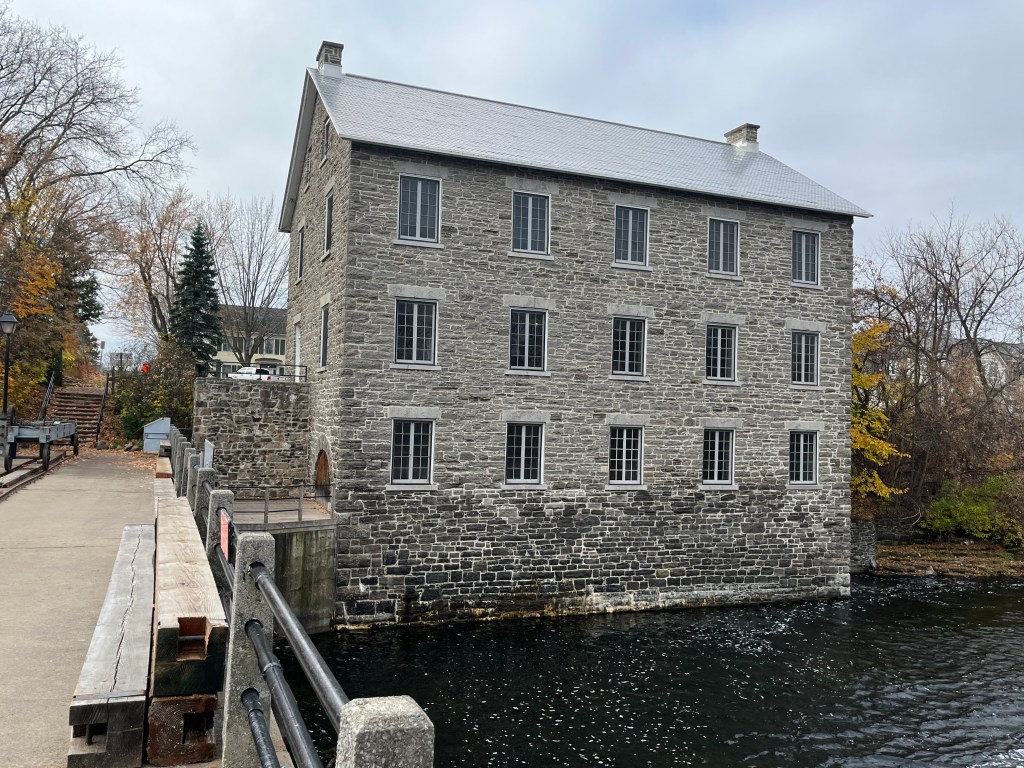October 30, 2022
My job as self-employed inspector under contract to various government inspection agencies gives me the opportunity to travel all over the province of Ontario. This past week, I spent 3 days working in the Ottawa area. During my travels I drove past the Watson Mill in Manotick and stopped to check it out. This mill continues to operate at select times and can be seen grinding grain which it sells as flour, along with baked bread. It wasn’t open when I was there, but you can take a virtual tour of the inside by clicking here.

Following the War of 1812 there was a general fear that the Americans would invade Canada again and so plans were put in place to create an inland military transportation route to supplement the St. Lawrence River. The construction of the canal brought many labourers and stone masons into the area and for the next few years most immigrants also came to the area via the canal. Moss Dickinson was 10 when the canal opened in 1832 and he saw the opportunity to commercialize the river and canal system. In 1858 a wooden dam was constructed at the future mill site using wood beams that were fastened to the rock with steel pins. The original dam can be seen in the archive image below.

In the late 1850s, Moss K. Dickinson and Joseph M. Currier owned a sawmill on the Rideau River, and they contracted Thomas Langell of Ottawa to build a grist mill to add to their growing industrial operations. It opened in 1860 with four runs of grinding stones which were powered by turbines that had been manufactured in Ottawa. In 1862 they added a woolen mill to the complex and the need for labour drew people to the area and the town of Manotick began to grow around the mills. In 1863 Dickinson bought out his partner and the mills remained in the family until 1929, operating under the name of The Long Island Mill. The Rideau Valley Conservation Authority purchased the mill in 1972 and restored it along with the Dickinson house and drive shed.

The construction of a sawmill, grist mill and carding or woolen mill provided the locals with the three basic necessities of life without the manual labour that had previously been required. The sawmill provided cut lumber for the construction of shelter, the grist mill provided flour for food and the woolen mill provided clothing. Alexander Spratt owned the mills after the Dickinson family and his family operated them until after the Second World War. Harry Watson bought the mill in 1946 and promptly changed the name to Watson’s Mill. He rebuilt the dam out of concrete in 1956 and today you can walk across the top of the mill to Long Island. A crane on wheels and rails was installed to raise and lower the stop logs that control the water level behind the dam.

Milling operations would cease in 1963 but the mill and dam remained as the most recognizable feature in the town of Manotick. From the middle of the dam the view upstream shows the slow-moving water behind the dam. Most of the fall colours had disappeared from the Ottawa region by this late in October but the scenery was still very beautiful.

In 1963 the National Capital Commission entered into an agreement with Watson to restore the mill and keep it as a functioning water-powered grist mill. In 1972 Watson sold his interests in the mill to the Rideau Valley Conservation Authority on condition that the mill remain known as Watson’s Mill. They completed the restoration and opened the mill as a tourist attraction in 1974.

Looking downstream you can see the cut-stone foundations from an earlier bridge across the Rideau River.

The view from the river side of the mill shows the Georgian symmetry of its three floor, five-bay construction.

Watson’s Mill in Manotick is one of only a few water-powered mills that still produce flour in all of Ontario and it is worth stopping for a visit if you are in the Ottawa area.
Google maps link: Watson’s Mill Manotick
Like us at http://www.facebook.com/hikingthegta
Follow us at http://www.hikingthegta.com
Also, look for us in Instagram

Manotick is such a lovely place to take a walk! (there is also an amazing donut place not far from the mill) 🙂